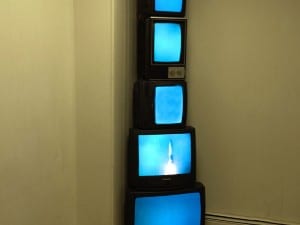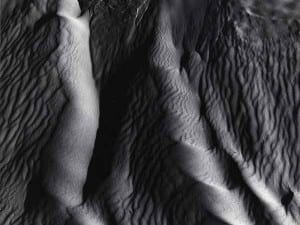History isn’t just out there, particles of memory floating around and whispering in the ears of the present. Since a story exists only in its telling, to convey truth requires mediation. The art projected in A Peculiar Form of Fiction lies in the area between truth and telling. In these films, artists interfere with and complicate perceptions of reality and fiction, and past and present, and are all the more revealing in doing so.
The ten-hour programme, screened across a two-day schedule, is curated by directors of S1 Artspace and Site Gallery and features six artists who draw on and experiment with conventions of documentary: Jeremy Deller, Gillian Wearing, Hito Steyerl, Duncan Campbell, John Smith and Phil Collins. At its opening, the exhibition complemented the bustle around Sheffield Doc/Fest with screenings in both galleries. It continues at S1 Artspace, in a rarely used expanse beneath the gallery – a utilitarian cinema-bunker suited to films that are, for the most part, stylistically unadorned and direct.
Deller’s Battle of Orgreave supplements the straight-up historical event documentary – talking heads overlaid with sound and vision bites – with an intervention in the process of recollection. Staging a re-enactment in 2001 of the miners’ strike’s most violent clash of police and pickets, he engages those who were there during the original just 17 years earlier, as well as seasoned battle re-enactors, in a confrontation with memory and representation. Participants address the misrepresentation of the turn of events by the media at the time, and so the act of storytelling becomes one of reclaiming history. Reconstruction comes with its own complications though; with original documentation so stinted and oral accounts so multitudinous, an objective truth is inconceivable. But to some extent the film fills a void in representation. The event now has a certain duality; Googling Battle of Orgreave returns a fairly even mixture of top results referring to the original incident and to the reconstruction.
Positioning aspects of a former reality in the present can create a new kind of engagement with history. In Phil Collins’ use! value! exchange! a former Marxism-Leninism teacher from the GDR recreates a pre-1989 lesson on Das Kapital to a university class in Berlin in 2010, and that same lesson takes on a different function. In some ways it’s alienating, as both head-scratching students and the audience feel the anachronism of this scenario. Images are intercut of Marx floating through treetops on the hook of a crane, his bronze statue being relocated in 2010, underlining the point that, though interpretations of Marx assume an altered position in today’s Berlin, past forces continue to be relevant to making sense of the present.
As these films make some form of fiction out of reality, they draw attention to the processes of filmmaking and storytelling themselves; none more so than John Smith’s amusing short, The Girl Chewing Gum. An everyday scene shot in London street in 1976, Smith initially seems to control the action with voiceover commands – ‘I want the two girls to come in from the right talking to each other’, ‘put the cigarette to your mouth… good’. It becomes increasingly clear, however, that this film’s fictionality is not ‘based on’ Smith’s directions, but rather the fiction ‘is’ the directions. He begins to assign motives and characters to passers by: man has robbed the Post Office and has a revolver in his pocket, another is on his way to the bank, two little boys are being naughty. It plays on audience consciousness of the conventions of scripted film and TV – the position of the director, plotlines, character development – and raises questions about authority and authenticity in representations of reality.
Gillian Wearing’s Self-Made is perhaps the closest to the format of reality TV: its participants responded to an advert calling for people to be in a film where they could play themselves or a fictional character, and were selected through an audition process; they’re conscious of the cameras and encouraged to emotionally ‘bare all’ in front of them. Yet as they engage with their past experiences through Method acting coaching and play out personal fictions, the viewers are put in an awkward, at times voyeuristic, position. The exhibition has conditioned the audience to question representations of reality, and Self-Made has a particularly conflicting effect. Though Wearing could not have predicted the outcome, as with reality TV there is some degree of control and manipulation. The line between person and assumed character is blurred, though the latter often reveals a deeper element of truth.
A Peculiar Form of Fiction is a challenge to its visitors; most of its films are at least half an hour in length and some over an hour. But it rewards time, for while each film tells stories that are either personal or are specific aspects of a larger narrative, they reveal in their own ways something of their wider social or political context. Whether that be changes in attitude that allowed a miner’s son to break out into a cross-dressing wrestling champion (in Deller’s So Many Ways to Hurt You) or the analogising of current economic crises through a Boering 4X-JYI plane, going spare and making the transition through Hollywood set pieces to being recycled into DVDs (in Steyerl’s In Free Fall). These works of art amalgamate fiction and reality to commentate and provoke thought on history and processes of truthful representation.
A Peculiar Form Of Fiction, 14/06/2012 until 21/07/2012, 120 Trafalgar Square, Sheffield, S1 4JT. www.s1artspace.org
Credits:
1. Gillian Wearing Self Made (2010)
Courtesy of Cornerhouse & Self Made Productions
2. Phil Collins Marxism Today (prologue) (2010) HD video projection with 5.1 surround sound German with English subtitles Duration: 35 minutes
Courtesy Shady Lane Productions and Tanya Bonakdar Gallery, New York
3. Phil Collins use! value! exchange! (2010) HD video projection with 5.1 surround sound German with English subtitles Duration: 21 minutes Courtesy Shady Lane Productions andTanya Bonakdar Gallery,New York
Text: Kathryn Hall





